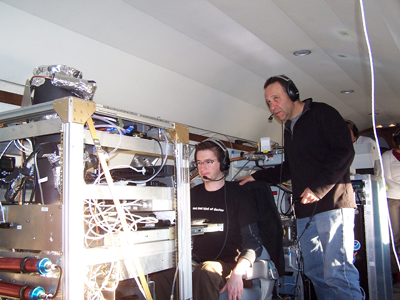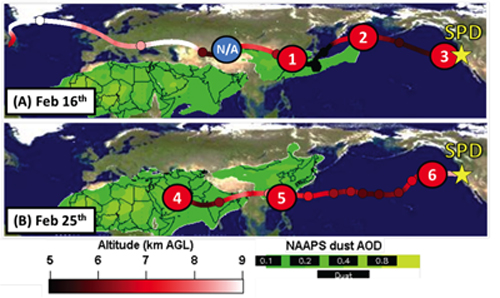Press Release: Asian Desert Dust Causes Californian Snowfall
Study Published by International Research Team, Including Carnegie Mellon's Ryan Sullivan, Published in Science Express
Contacts: Jocelyn Duffy / 412-268-9982 / jhduffy@andrew.cmu.edu
Chriss Swaney / 412-268-5776 / swaney@andrew.cmu.edu
 PITTSBURGH—The next time you try to catch a snowflake on your tongue, just think that the particle at the core of that snowflake may have traveled thousands of miles from a desert in Asia before it fell from the sky above the United States. A new study published online in Science Express by an international group of researchers, including Carnegie Mellon University's Ryan Sullivan, has found that airborne dust and biological particles from the Sahara Desert in Africa and deserts in Asia can form the nucleus of ice-induced precipitation in California's Sierra Nevada mountain range.
PITTSBURGH—The next time you try to catch a snowflake on your tongue, just think that the particle at the core of that snowflake may have traveled thousands of miles from a desert in Asia before it fell from the sky above the United States. A new study published online in Science Express by an international group of researchers, including Carnegie Mellon University's Ryan Sullivan, has found that airborne dust and biological particles from the Sahara Desert in Africa and deserts in Asia can form the nucleus of ice-induced precipitation in California's Sierra Nevada mountain range.
Snow in the Sierra Nevada provides a significant source of water to the region and the study's authors say that finding ways to predict ice-initiated precipitation is crucial for water resource management.
"The timing of when snow falls, and how much snow falls is important to the Sierra Nevada's vegetation and water supply, much as it is in many parts of the world. Despite its importance, we cannot accurately predict snowfall," said Sullivan, an assistant professor of chemistry and mechanical engineering at CMU and a member of CMU's Center for Atmospheric Particle Studies.
Clouds are made up of small droplets of water. When the droplets in the clouds freeze, they fall to Earth in the form of snow, ice, hail and graupal. These ice crystals can only form at extremely cold temperatures - around negative 38 degrees Celsius. In order to freeze at more moderate temperatures, the droplets need to attach to a catalyst called an ice nucleus, which can be any of a variety of particles, but are most often mineral dust or biological particles. Ice nuclei are very rare, typically ranging from one to 10 particles per million in the atmosphere.
"We've shown that the detection of ice nuclei might be a key variable in predicting the amount and type of precipitation an area can expect," Sullivan said.
 In February and March, heavy winds create clouds of dust in Asian deserts and the Sahara that become lofted high into the free troposphere. According to satellite images, those dust clouds travel over the Pacific Ocean, arriving at the West Coast of the United States about a week or two later. Analysis of residue from snow that fell in Sierra Nevada during that time revealed evidence of Asian mineral dust, leading researchers to believe the snow was nucleated on mineral dust ice nuclei.
In February and March, heavy winds create clouds of dust in Asian deserts and the Sahara that become lofted high into the free troposphere. According to satellite images, those dust clouds travel over the Pacific Ocean, arriving at the West Coast of the United States about a week or two later. Analysis of residue from snow that fell in Sierra Nevada during that time revealed evidence of Asian mineral dust, leading researchers to believe the snow was nucleated on mineral dust ice nuclei.
To test this theory, the team of researchers from the University of California, San Diego (UCSD), The Hebrew University of Jerusalem, Colorado State University, Carnegie Mellon University, National Oceanic and Atmospheric Administration (NOAA) Earth System Research Laboratory, Scripps Institution of Oceanography, NASA Langley Research Center and Pacific Northwest National Laboratory (PNNL) used a combination of air- and ground-based techniques to gather data about the interactions between aerosol particles, clouds and precipitation over Sierra Nevada for one month in winter of 2011. Their research was completed as part of the CalWater field campaign.
Sullivan, along with others on the research team flew over the Sierra Nevada in a specially equipped Department of Energy Gulfsream-1 aircraft equipped with instruments that allowed them to measure the cloud particles and aerosol particles surrounding the clouds. Sullivan and Paul DeMott, a senior research scientist in Colorado State University's Atmospheric Chemistry Program, used an ice simulation chamber called a continuous flow diffusion chamber to analyze particles from outside the aircraft. In the chamber, they exposed the particles to controlled ice cloud formation conditions and counted the number of ice particles that were formed. From this, they determined how many ice nuclei were present in the atmosphere outside the aircraft. Other group members used a technique called aerosol time of flight mass spectrometry (ATOFMS) to determine what types of particles were present in the air and clouds. From this combined dataset they were able to prove that the clouds that had the most ice nuclei also had the most Asian mineral dust - and that those clouds were most likely to produce precipitation.
The researchers also found that heavy precipitation was caused by a "seeder-feeder" mechanism, in which the ice crystals nucleated on dust particles would fall from their upper-level glaciated clouds and through a lower layer of supercooled liquid clouds. The water droplets in the lower layer of clouds would freeze and precipitate, creating an increased amount of snow. These lower liquid clouds likely would not have precipitated had they not been seeded by the ice crystals sedimenting out of the upper ice clouds.
In addition to Sullivan and DeMott, the study was co-authored by Jessie M. Creamean, Kaitlyn J. Suski and Alberto Cazorla of UCSD; Daniel Rosenfield of The Hebrew University of Jerusalem; Allen B. White of NOAA; F. Martin Ralph of NOAA and the Scripps Institution of Oceanography; Patrick Minnis of NASA Langley Research Center; Jennifer A. Comstock and Jason M. Tomlinson of PNNL; and Kimberly Prather of UCSD and the Scripps Institution of Oceanography. Funding for the project was provided by the California Energy Commission, and grants to individual researchers (see the paper for more detail).
###
In the top photo Carnegie Mellon's Ryan Sullivan (seated) and Paul DeMott of Colorado State University collect atmospheric data aboard a Department of Energy G-1 aircraft as part of the CalWater campaign.
The map shows the path of aerosols that reached California in 2011. Circled numbers indicate locations in which dust was captured in satellite images. Image: Science